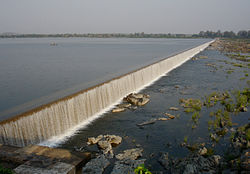Location
The Lower Manair Dam is located on the Manair River at 18°24' N latitude and 79° 20' E longitude in Karimnagar District at Km.146 of Kakatiya Canal. The Manair River is a tributary of the Godavari River and the dam is built across the river at the confluence with Mohedamada River. The dam drains a catchment area of 6,464 square kilometres (2,496 sq mi) which includes 1,797.46 square kilometres (694.00 sq mi) of free catchment and the balance is intercepted catchment. [4] [5] Karimanagar town is 6 kilometres (3.7 mi) away from the dam. [6]
In the vicinity of the LMD which is the only place of recreation for the people of Karimnagar, in the light of recent drowning incidents and the insecurity created by hooligans, security measures have been stepped up. [7]
Features
Lower Manair Dam's construction was started in 1974 and commissioned in 1985. It is an Earth cum Masonry dam. The dam height above the deepest foundation is 41 metres (135 ft); the maximum height of the earth dam is 88 feet (27 m). The dam length is 10,471 metres (34,354 ft), top width is 24 feet (7.3 m). It has a volume content of 5.41 million cum with a reservoir water spread area of 81 square kilometres (31 sq mi) at FRL of 280 m (920 ft). The gross storage capacity of the reservoir is 680 million cubic meters and the effective storage capacity is 621 million cubic meters (Mcm). The spillway is designed for discharge of capacity 14,170 cubic metres (500,000 cu ft)/ second (and is controlled by 20 gates [6] of 15.24 by 7.31 metres (50.0 ft × 24.0 ft) size, [5] while the maximum observed flood discharge is reported to be 9,910 cubic metres (350,000 cu ft)/second. [4] [8]
The storage behind the dam serves as a balancing reservoir for the Kakatiya Canal and regulates flow for irrigation. [9] The command area for irrigation is 163,000 hectares (400,000 acres).
The water quality status of the Lower Manair Reservoir was studied from September 2009 to August 2010 for the physico- chemical parameters such as water temperature, pH, turbidity, transparency, total dissolved solids, total hardness, chlorides, phosphate, nitrates, dissolved oxygen (DO) and biological oxygen demand (BOD). The results indicated that all parameters of water quality were within permissible limits and it was concluded that the water in the reservoir was fit for use for irrigation, drinking water supply and pisciculture. [10]
This page is based on this
Wikipedia article Text is available under the
CC BY-SA 4.0 license; additional terms may apply.
Images, videos and audio are available under their respective licenses.






